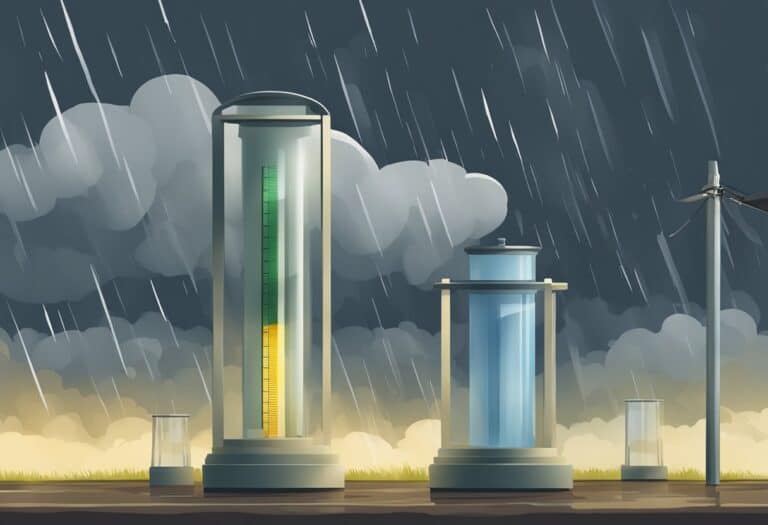When you encounter an anticyclone, you’re likely to experience weather that’s markedly different from the conditions brought on by its counterpart, the cyclone.
Anticyclones, which are systems of high atmospheric pressure, are characterized by outward-spiraling winds that descend from higher altitudes to the surface. This motion generally leads to clear skies and stable weather conditions. In these high-pressure areas, the air is denser and cooler than the surrounding air, a feature that plays a crucial role in the weather they bring.
Due to the nature of anticyclones, the weather is often temperate and dry. The system’s clockwise circulation in the Northern Hemisphere (and counterclockwise in the Southern Hemisphere) acts to push away clouds, allowing for ample sunshine. However, the specific weather conditions can vary based on the anticyclone’s location, season, and intensity.
For instance, during winter, an anticyclone can lead to cold, frosty mornings and minimal wind, while in the summer, it can bring hot, dry weather. Understanding the behavior and impact of anticyclones is not only important for weather forecasting but also for preparing for environmental and societal effects that these systems can have.
Anticyclones, or high-pressure systems, typically bring clear, stable weather due to descending air suppressing cloud formation. Weather can vary with location and season, ranging from cold, frosty conditions in winter to hot, dry weather in summer. Understanding anticyclones’ impact is crucial for weather forecasting and preparation.
Characteristics of Anticyclones
Anticyclones, or high-pressure systems, shape your weather with distinct characteristics. They involve large-scale circulation of wind around a central area of high atmospheric pressure.
Pressure and Circulation Patterns
In the northern hemisphere, anticyclones exhibit a clockwise rotation of winds around the high-pressure center, while in the southern hemisphere, the winds rotate in an anticlockwise direction. This is a result of the Coriolis effect, which is due to the Earth’s rotation. The pressure within these systems is higher than the surrounding area, creating a force that pushes air away from the center, known as horizontal divergence.
Direction of Winds
Anticyclones guide air to flow outward from the highest pressure at the center toward the lower pressure areas surrounding it. This flow creates divergent wind patterns at the surface. Due to the Coriolis effect, these winds are directed to the right in the northern hemisphere, forming a clockwise pattern, and to the left in the southern hemisphere, forming an anticlockwise pattern.
Air Movement and Stability
The air movement within an anticyclone is primarily characterized by subsidence, which is the sinking of air from higher levels of the atmosphere toward the ground. As the air descends, it warms by compression, which discourages cloud formation and leads to generally clear and stable weather conditions. The sinking air tends to suppress convective activity, such as thunderstorms, resulting in less precipitation and more consistent weather.
Weather Patterns Associated with Anticyclones
When an anticyclone affects your area, you can anticipate distinctive weather patterns that include consistent clear skies, particular temperature variations, and seasonal impacts.
Clear Skies and Dry Conditions
Anticyclones are synonymous with clear skies and dry weather. Because anticyclones involve high atmospheric pressure, they discourage the formation of clouds, often resulting in cloudless skies. During these conditions, your chances of experiencing rain are minimal, making outdoor activities quite favorable. However, under certain conditions, anticyclones can lead to the formation of fog, especially during the night and morning hours when the ground cools rapidly under the clear skies.
Temperature Variations
Temperatures under an anticyclone can vary significantly. During the day, without clouds to shield you from the sun, it can become quite warm, allowing for a rise in heat levels. At night, these conditions reverse as the absence of clouds can lead to rapid cooling, which might result in frost, particularly in areas with high humidity levels.
Seasonal Variations
Seasonal differences have a profound influence on the characteristics of an anticyclone. A winter anticyclone might bring exceptionally cold and dry conditions, with lower humidity levels, creating potential hazards like black ice. In contrast, a summer anticyclone often leads to hot and dry conditions that can escalate into heatwaves. While dry weather is generally expected with anticyclones, how hot or cold it feels is highly dependent on the time of year.
Geographic and Seasonal Influence

Anticyclones, or high-pressure systems, exhibit characteristics heavily dictated by their geographic location and the time of year. Their behavior affects weather patterns and can result in distinct weather conditions depending on the latitude and season.
Latitudinal Influence on Anticyclones
Anticyclones at higher latitudes, particularly near the poles, often result in clear, dry, and cold conditions. Their formation is usually associated with cold air masses that descend and spread outwards. Conversely, anticyclones at lower latitudes, closer to the equator, often bring dry and warm weather since they are typically composed of warm air that is descending. These subtropical anticyclones can lead to calm and stable weather patterns.
Anticyclones in Different Hemispheres
The influence of anticyclones can differ between the Northern and Southern Hemispheres due to the Coriolis effect. Anticyclonic winds spiral outwards in a clockwise direction in the Southern Hemisphere and counter-clockwise in the Northern Hemisphere. This means ocean currents and weather patterns will vary depending on the hemisphere. For example, the Bermuda High, a subtropical anticyclone in the Northern Hemisphere, can impact hurricane formation and movement in the Atlantic Ocean.
Seasonal Behavior of Anticyclones
The seasonal changes have a pronounced effect on the behavior of anticyclones. During the summer, warm anticyclones can cause heatwaves, especially when they are stationary. In the winter, cold anticyclones can lead to frosty, foggy conditions as cold air settles closer to the ground. Furthermore, regions may experience different weather depending on whether a warm or cold anticyclone is influencing the area. For instance, a warm anticyclone in winter could bring milder conditions than expected for the season.
Impact on Local and Global Weather
Anticyclones, as large-scale weather systems characterized by high atmospheric pressure, significantly shape your local and global weather experiences. Their influence ranges from the stabilization of weather conditions to the modulation of long-term weather patterns, sometimes playing a role in extreme weather events.
Weather Forecasting and Anticyclones
When anticyclones make their presence known in your area, you can expect a period of calmer weather. These systems are associated with clear skies and subdued wind activity due to the high atmospheric pressure that suppresses cloud formation. Forecasters often look for these high-pressure areas as indicators of stable weather conditions. Anticyclones tend to move more slowly than depressions (low-pressure systems), and this sluggish movement allows for more predictable and extended weather patterns.
Long-Term Weather Patterns
On a broader scale, anticyclones influence long-term weather patterns. They can form blocking highs, which are large, persistent anticyclones that remain in place for an extended period. These blocking systems can disrupt the normal movement of weather around the globe, sometimes leading to prolonged periods of dry or wet weather, depending on where you are. For instance, they can lead to drought conditions by preventing moist air from reaching a region.
Extremes of Weather
Although anticyclones are usually associated with fair weather, they can indirectly contribute to extreme weather events. For example, the strength and position of an anticyclone can steer the path of cyclones, altering their trajectory and intensity. During the summer, the clear skies and calm winds associated with anticyclones can lead to heatwaves, as the sun intensely heats the surface without the relief of cloud cover or precipitation.
Environmental and Societal Effects
When an anticyclone settles in your region, it impacts both the environment and society in distinct ways. Understanding these effects helps you prepare and adapt to the prevailing conditions.
Climate Impact
Anticyclones bring about a change in climate patterns due to the high atmospheric pressure associated with them. Typically, you can expect drier conditions, as anticyclones inhibit cloud formation, reducing the likelihood of precipitation. This lack of rain can lead to drought-like conditions, affecting crop yields and water supply. In colder seasons, clear skies can lead to sharp drops in temperature, creating a phenomenon known as a cold snap.
Air Quality Implications
The air quality during an anticyclonic period is affected due to the stability of the ground atmosphere. When high pressure dominates, the air becomes stagnant, which means pollutants and ozone can accumulate, leading to reduced air quality. Cities like Los Angeles and Mexico City, which are prone to smog, often experience poor air quality during these events. The absence of strong winds prevents dispersal of pollutants, and solar radiation can trigger photochemical smog formation, exacerbating health issues.
Effects on Human Activity
The influence of an anticyclone extends to various human activities. In agriculture, low precipitation impacts irrigation and can stress water resources. For outdoor activities, you may enjoy more sunny days, but the need to consider UV exposure and air quality is heightened. In urban settings, the poor air quality may cause health advisories, affecting outdoor events and causing an increase in hospital visits for respiratory issues. Furthermore, aviation and maritime operations often benefit from predictable weather patterns, leading to smoother journeys and operations.
Scientific Understanding and Research
In exploring the impact of anticyclones on weather patterns, you will encounter comprehensive meteorological studies, observations of anticyclones beyond Earth, and cutting-edge advances in weather prediction technologies. Each element contributes to a clearer picture of the significant role high-pressure systems play in shaping local and global climates.
Meteorological Studies
Your understanding of anticyclones—high-pressure systems that generally bring dry, clear weather—is grounded in a body of meteorological studies. Anticyclones, in contrast to cyclones, cause air to descend and warm by compression, often leading to stable weather conditions without precipitation. Ground-based weather stations and weather charts play pivotal roles in tracking these systems, helping you anticipate sunny skies and calm weather. Through Earth science research, it’s recognized that the strength and position of anticyclones can influence the severity and duration of weather experienced in a region.
Extraterrestrial Anticyclones
Turning your gaze to the heavens, Jupiter provides a fascinating subject with its famous Great Red Spot and lesser-known Oval BA—both colossal anticyclones. Insights into these vast high-pressure systems help you draw parallels and spot differences with terrestrial weather patterns, enriching your grasp of atmospheric dynamics. The sheer scale of these extraterrestrial anticyclones underscores the diverse manifestations of high-pressure phenomena across the solar system.
Advancements in Weather Prediction
Recent advances in technology have substantially improved your ability to predict and understand the effects of anticyclones. Sophisticated computer models and satellite data now enable more accurate visualization and forecasting of these weather systems. With these tools, you’re better equipped to interpret how anticyclones will influence local weather, from balmy, clear days to the exacerbation of urban heat islands and droughts, enhancing both short-term weather forecasts and long-term climate models.
Frequently Asked Questions
In this section, you’ll find clear answers about the weather phenomena caused by anticyclones, which are essential for understanding daily weather patterns as well as the broader climatic influences these systems exert.
What are the distinguishing characteristics of anticyclonic weather conditions?
Anticyclonic weather conditions typically bring clear skies and calm weather due to the descending air that inhibits cloud formation. In an anticyclone, you can expect reduced wind speeds and the stabilization of the atmosphere, leading to less precipitation.
How does air movement in anticyclones differ between hemispheres?
The direction of air movement in anticyclones is clockwise in the Northern Hemisphere and counterclockwise in the Southern Hemisphere due to the Coriolis effect. This deflection is caused by the rotation of the Earth and impacts the way weather systems develop and move in each hemisphere.
What types of weather are associated with the presence of an anticyclone?
With the presence of an anticyclone, you’re likely to encounter sunny and dry weather. These conditions result from the high pressure that suppresses cloud formation and precipitation, often giving way to clear skies and mild temperatures, particularly in the summer months.
How do anticyclones compare to cyclones in terms of atmospheric effects?
Anticyclones and cyclones have opposite effects on the atmosphere: while anticyclones are associated with high pressure and descending air leading to stable conditions, cyclones are characterized by low pressure, ascending air, and more turbulent weather, including heavy rainfall and strong winds.
In what ways can anticyclones impact weather patterns and climates?
Anticyclones can impact weather patterns by bringing extended periods of quiet and dry conditions, which can lead to droughts in certain areas. Moreover, during winter, anticyclones can result in cold snaps and temperature inversions, potentially leading to foggy conditions and poor air quality.
What meteorological processes lead to the formation of anticyclones?
Meteorological processes causing the formation of anticyclones include the radiational cooling of the Earth’s surface, especially during clear, calm nights, and the divergence of air higher in the atmosphere. These processes cause an increase in atmospheric pressure at the surface, subsequently leading to anticyclonic conditions.







